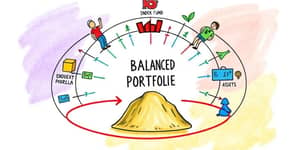
Major life events often create a turning point in our financial lives, challenging even experienced investors to reassess their strategies. Whether you are welcoming a new child or approaching retirement, these moments demand attention beyond mere celebration.
At the core of a well-structured investment plan lies the critical practice of portfolio rebalancing: the periodic act of buying and selling assets to restore your portfolio to target allocation. Without it, even the most carefully constructed portfolios can drift off course over time.
Over time, equities may outpace fixed income, real estate holdings can lag, and alternative investments might shift relative weightings. Without active maintenance, even a modest drift can lead to unintended risk concentration over time, undercutting your intended strategy.
Major milestones such as marriage, childbirth, or the loss of a loved one can profoundly shift your financial goals and emotional outlook. These changes often translate into risk tolerance and goals adjustments, making it imperative to realign your investments with your new reality.
In each scenario, your time horizon and liquidity needs can change dramatically. The arrival of a newborn calls for a longer investment horizon, while impending retirement reinforces the need for capital preservation. Recognizing these shifts enables you to manage risk and maintain diversification, safeguarding long-term objectives despite life’s unpredictability.
Moreover, life transitions often affect cash flow needs and emergency reserves. A growing family may need greater liquidity, while a career change might introduce income uncertainty. Rebalancing can free up necessary funds and align your assets with new cash flow demands.
Investor needs evolve as they journey through different life stages. A dynamic rebalancing plan should reflect these evolving priorities, from aggressive growth to wealth preservation.
Early in your career, you typically enjoy a long buffer against market downturns, making an aggressive equity stance appropriate. In mid-career, rising responsibilities and peak earning years often lead to a more balanced mix. As retirement nears, safeguarding capital with income-generating assets and a conservative posture becomes paramount.
As you progress, consider diversifying beyond traditional stocks and bonds. Adding real estate, commodities, or international equities can reduce correlation and enhance risk-adjusted returns. However, each additional asset class requires thoughtful integration into your overall strategic allocation plan.
Taxes also factor into your rebalancing decisions. Capital gains in taxable accounts may push you to lean on tax-advantaged vehicles for adjustment. Coordinating across retirement and brokerage accounts ensures you don’t inadvertently accumulate excess risk in a single account type.
Each method has trade-offs. Selling winners to buy laggards enforces the discipline to buy low, sell high with discipline, but may incur capital gains taxes. Directing fresh contributions toward underweighted classes can reduce transaction costs while gradually nudging allocations back to target.
For hands-off investors, target-date funds and robo-advisors offer automated rebalancing, adhering to predefined glide paths that adjust allocations over time. While convenient, you should still monitor to ensure the model aligns with your personal risk profile and financial objectives.
Always weigh the impact of transaction fees and tax implications before executing trades. In taxable accounts, you may prefer threshold-based rebalancing to minimize realized gains, whereas in tax-advantaged accounts you can adjust more freely.
Timing plays a crucial role in maintaining portfolio integrity. Two popular strategies include:
Calendar-based rebalancing sets fixed check-ins—quarterly, semiannual, or annual—to realign allocations. This approach fosters routine discipline but may overlook significant portfolio drift between checkpoints.
Threshold-based rebalancing triggers adjustments when an asset class deviates by a set percentage—commonly 5% to 10%—from its target. This method directly responds to market movements but requires ongoing monitoring.
Regular rebalancing can also mitigate the emotional toll of market volatility. By committing to systematic reviews, you avoid making impulsive shifts when markets swing dramatically, preserving both capital and investor peace of mind in downturns.
Combining both strategies can balance the benefits: schedule periodic reviews while watching for substantial allocation drifts that warrant immediate action.
Consider a portfolio originally set at 60% stocks and 40% bonds. Following a strong equity rally, stocks surge to 80%, while bonds fall to 20%. This shift exposes you to increased market volatility and risk concentration, potentially jeopardizing your objectives.
Suppose your total portfolio is $500,000. At an 80/20 split, stocks amount to $400,000 and bonds to $100,000. Selling $100,000 of equities and buying bonds recalibrates to a $300,000/$200,000 mix, restoring stability. This disciplined reallocation can smooth returns over the next market cycle.
By taking swift action when life changes occur, you can reinforce long-term financial discipline and focus, preventing reactive or emotionally driven decisions.
Document each rebalance decision and record the rationale. This history builds accountability and can inform future choices. Don’t forget to revisit estate planning documents and beneficiary designations following significant life changes.
Major life events often redefine your financial landscape, but they also offer opportunities to refine and strengthen your investment strategy. Regular rebalancing—whether calendar-based or threshold-driven—helps you stay aligned with evolving goals and risk preferences.
Embrace rebalancing as a cornerstone of prudent investing. By maintaining discipline, managing risk, and adjusting to life’s milestones, you ensure your portfolio remains resilient through every chapter of your journey.
Start today by scheduling your next portfolio review. Life will always evolve, and a proactive approach to rebalancing empowers you to navigate every milestone with confidence and clarity.
References













